| Listing 1 - 9 of 9 |
Sort by
|

ISBN: 0262700875 0262201275 0262284987 0585263809 9780585263809 9780262201278 9780262700870 9780262284981 Year: 2002 Publisher: Cambridge : MIT Press
Abstract | Keywords | Export | Availability | Bookmark
 Loading...
Loading...Choose an application
- Reference Manager
- EndNote
- RefWorks (Direct export to RefWorks)
Annotation
Machine learning. --- Computer Science --- Engineering & Applied Sciences --- Machine learning --- #PBIB:2001.2 --- Learning, Machine --- Artificial intelligence --- Machine theory --- E-books --- COMPUTER SCIENCE/Artificial Intelligence
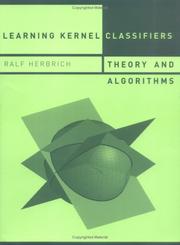
ISBN: 1282096389 0262256339 9786612096389 0585436681 026208306X 9780262256339 9780585436685 9780262083065 0262263041 Year: 2002 Publisher: Cambridge, Mass. : MIT Press,
Abstract | Keywords | Export | Availability | Bookmark
 Loading...
Loading...Choose an application
- Reference Manager
- EndNote
- RefWorks (Direct export to RefWorks)
Linear classifiers in kernel spaces have emerged as a major topic within the field of machine learning. The kernel technique takes the linear classifier--a limited, but well-established and comprehensively studied model--and extends its applicability to a wide range of nonlinear pattern-recognition tasks such as natural language processing, machine vision, and biological sequence analysis. This book provides the first comprehensive overview of both the theory and algorithms of kernel classifiers, including the most recent developments. It begins by describing the major algorithmic advances: kernel perceptron learning, kernel Fisher discriminants, support vector machines, relevance vector machines, Gaussian processes, and Bayes point machines. Then follows a detailed introduction to learning theory, including VC and PAC-Bayesian theory, data-dependent structural risk minimization, and compression bounds. Throughout, the book emphasizes the interaction between theory and algorithms: how learning algorithms work and why. The book includes many examples, complete pseudo code of the algorithms presented, and an extensive source code library.
Engineering & Applied Sciences --- Computer Science --- Computer science --- Mathematical statistics --- Machine learning --- Algorithms --- E-books --- Algorithms. --- Machine learning. --- Apprentissage automatique --- Algorithmes --- Algorism --- Algebra --- Arithmetic --- Learning, Machine --- Artificial intelligence --- Machine theory --- Foundations --- COMPUTER SCIENCE/Machine Learning & Neural Networks
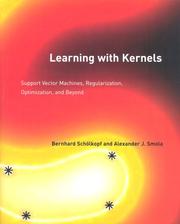
ISBN: 0262194759 0262256932 0585477590 9780262194754 9780262256933 9780585477596 Year: 2002 Publisher: Cambridge: MIT Press,
Abstract | Keywords | Export | Availability | Bookmark
 Loading...
Loading...Choose an application
- Reference Manager
- EndNote
- RefWorks (Direct export to RefWorks)
In the 1990s, a new type of learning algorithm was developed, based on results from statistical learning theory: the Support Vector Machine (SVM). This gave rise to a new class of theoretically elegant learning machines that use a central concept of SVMs -- -kernels--for a number of learning tasks. Kernel machines provide a modular framework that can be adapted to different tasks and domains by the choice of the kernel function and the base algorithm. They are replacing neural networks in a variety of fields, including engineering, information retrieval, and bioinformatics. Learning with Kernels provides an introduction to SVMs and related kernel methods. Although the book begins with the basics, it also includes the latest research. It provides all of the concepts necessary to enable a reader equipped with some basic mathematical knowledge to enter the world of machine learning using theoretically well-founded yet easy-to-use kernel algorithms and to understand and apply the powerful algorithms that have been developed over the last few years.
Complex analysis --- Computer assisted instruction --- Artificial intelligence. Robotics. Simulation. Graphics --- Machine learning --- Algorithms --- Kernel functions --- Apprentissage automatique --- Algorithmes --- Noyaux (Mathématiques) --- Machine Learning. --- Algorithms. --- Support vector machines. --- Kernel functions. --- Functions, Kernel --- SVMs (Algorithms) --- Noyaux (Mathématiques) --- Support vector machines --- Supervised learning (Machine learning) --- Functions of complex variables --- Geometric function theory --- E-books --- Machine learning. --- Algorism --- Algebra --- Arithmetic --- Learning, Machine --- Artificial intelligence --- Machine theory --- Foundations --- COMPUTER SCIENCE/Machine Learning & Neural Networks

ISBN: 0199252777 9780199252770 Year: 2002 Publisher: Oxford: Clarendon,
Abstract | Keywords | Export | Availability | Bookmark
 Loading...
Loading...Choose an application
- Reference Manager
- EndNote
- RefWorks (Direct export to RefWorks)
Artificial intelligence --- Machine learning. --- Artificial intelligence. --- Machine learning --- AI (Artificial intelligence) --- Artificial thinking --- Electronic brains --- Intellectronics --- Intelligence, Artificial --- Intelligent machines --- Machine intelligence --- Thinking, Artificial --- Bionics --- Cognitive science --- Digital computer simulation --- Electronic data processing --- Logic machines --- Machine theory --- Self-organizing systems --- Simulation methods --- Fifth generation computers --- Neural computers --- Learning, Machine --- Searle, John R. --- Searle, J. R. --- Searle, John Rogers --- 존 설
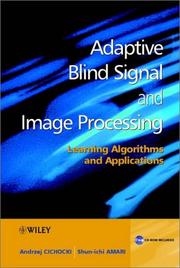
ISBN: 0471607916 9780471607915 Year: 2002 Publisher: Chichester: Wiley,
Abstract | Keywords | Export | Availability | Bookmark
 Loading...
Loading...Choose an application
- Reference Manager
- EndNote
- RefWorks (Direct export to RefWorks)
681.3*I2 --- 681.3*I2 Artificial intelligence. AI --- Artificial intelligence. AI --- Adaptive signal processing --- Algorithms --- Machine learning --- Learning, Machine --- Artificial intelligence --- Machine theory --- Algorism --- Algebra --- Arithmetic --- Signal processing, Adaptive --- Signal processing --- Foundations --- Machine Learning --- Adaptive signal processing. --- Algorithms. --- Machine learning. --- Traitement du signal

ISBN: 1281072915 9786611072919 0080500188 0585456615 9780585456614 9781558607835 1558607838 9780080500188 Year: 2002 Publisher: San Francisco : Morgan Kaufmann Publishers,
Abstract | Keywords | Export | Availability | Bookmark
 Loading...
Loading...Choose an application
- Reference Manager
- EndNote
- RefWorks (Direct export to RefWorks)
Blondie24 tells the story of a computer that taught itself to play checkers far better than its creators ever could by using a program that emulated the basic principles of Darwinian evolution--random variation and natural selection-- to discover on its own how to excel at the game. Unlike Deep Blue, the celebrated chess machine that beat Garry Kasparov, the former world champion chess player, this evolutionary program didn't have access to strategies employed by human grand masters, or to databases of moves for the endgame moves, or to other human expertise about the
Artificial intelligence. --- Machine learning. --- Evolutionary computation. --- Computer checkers. --- Checkers --- Computation, Evolutionary --- Learning, Machine --- AI (Artificial intelligence) --- Artificial thinking --- Electronic brains --- Intellectronics --- Intelligence, Artificial --- Intelligent machines --- Machine intelligence --- Thinking, Artificial --- Data processing --- Neural networks (Computer science) --- Artificial intelligence --- Machine theory --- Bionics --- Cognitive science --- Digital computer simulation --- Electronic data processing --- Logic machines --- Self-organizing systems --- Simulation methods --- Fifth generation computers --- Neural computers --- Machine learning --- Evolutionary computation --- Computer checkers --- E-books
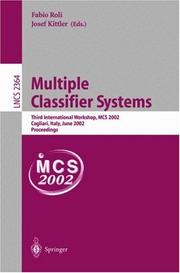
ISBN: 3540438181 3540454284 Year: 2002 Publisher: Berlin, Heidelberg : Springer Berlin Heidelberg : Imprint: Springer,
Abstract | Keywords | Export | Availability | Bookmark
 Loading...
Loading...Choose an application
- Reference Manager
- EndNote
- RefWorks (Direct export to RefWorks)
Machine learning --- Neural networks (Computer science) --- Pattern perception --- Computer Science --- Engineering & Applied Sciences --- Computer science. --- Algorithms. --- Artificial intelligence. --- Image processing. --- Pattern recognition. --- Computer engineering. --- Computer Science. --- Computer Engineering. --- Artificial Intelligence (incl. Robotics). --- Pattern Recognition. --- Image Processing and Computer Vision. --- Algorithm Analysis and Problem Complexity. --- Computers --- Design perception --- Pattern recognition --- Form perception --- Perception --- Figure-ground perception --- Pictorial data processing --- Picture processing --- Processing, Image --- Imaging systems --- Optical data processing --- AI (Artificial intelligence) --- Artificial thinking --- Electronic brains --- Intellectronics --- Intelligence, Artificial --- Intelligent machines --- Machine intelligence --- Thinking, Artificial --- Bionics --- Cognitive science --- Digital computer simulation --- Electronic data processing --- Logic machines --- Machine theory --- Self-organizing systems --- Simulation methods --- Fifth generation computers --- Neural computers --- Algorism --- Algebra --- Arithmetic --- Informatics --- Science --- Design and construction --- Foundations --- Optical pattern recognition. --- Computer vision. --- Computer software. --- Artificial Intelligence. --- Software, Computer --- Computer systems --- Machine vision --- Vision, Computer --- Artificial intelligence --- Image processing --- Pattern recognition systems --- Perceptrons --- Visual discrimination --- Ensemble learning (Machine learning) --- Optical data processing. --- Optical computing --- Visual data processing --- Integrated optics --- Photonics --- Optical equipment --- Classifier combination (Machine learning) --- Committee-based learning (Machine learning) --- Ensemble methods (Machine learning) --- Multiple classifier systems (Machine learning) --- Distributed cognition --- Knowledge acquisition (Expert systems) --- Pattern perception.
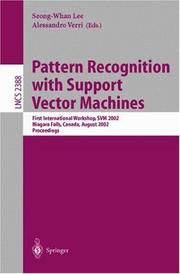
ISSN: 03029743 ISBN: 354044016X 9783540440161 3540456651 Year: 2002 Volume: 2388 Publisher: Berlin, Heidelberg : Springer Berlin Heidelberg : Imprint: Springer,
Abstract | Keywords | Export | Availability | Bookmark
 Loading...
Loading...Choose an application
- Reference Manager
- EndNote
- RefWorks (Direct export to RefWorks)
Pattern recognition systems --- Support vector machines --- Computer science. --- Computers. --- Algorithms. --- Artificial intelligence. --- Image processing. --- Pattern recognition. --- Statistics. --- Computer Science. --- Pattern Recognition. --- Image Processing and Computer Vision. --- Algorithm Analysis and Problem Complexity. --- Computation by Abstract Devices. --- Artificial Intelligence (incl. Robotics). --- Statistics and Computing/Statistics Programs. --- SVMs (Algorithms) --- Algorithms --- Kernel functions --- Supervised learning (Machine learning) --- Optical pattern recognition. --- Computer vision. --- Computer software. --- Mathematical statistics. --- Artificial Intelligence. --- AI (Artificial intelligence) --- Artificial thinking --- Electronic brains --- Intellectronics --- Intelligence, Artificial --- Intelligent machines --- Machine intelligence --- Thinking, Artificial --- Bionics --- Cognitive science --- Digital computer simulation --- Electronic data processing --- Logic machines --- Machine theory --- Self-organizing systems --- Simulation methods --- Fifth generation computers --- Neural computers --- Mathematics --- Statistical inference --- Statistics, Mathematical --- Statistics --- Probabilities --- Sampling (Statistics) --- Informatics --- Science --- Software, Computer --- Computer systems --- Machine vision --- Vision, Computer --- Artificial intelligence --- Image processing --- Optical data processing --- Pattern perception --- Perceptrons --- Visual discrimination --- Statistical methods --- Optical data processing. --- Statistics . --- Statistical analysis --- Statistical data --- Statistical science --- Econometrics --- Automatic computers --- Automatic data processors --- Computer hardware --- Computing machines (Computers) --- Electronic calculating-machines --- Electronic computers --- Hardware, Computer --- Cybernetics --- Calculators --- Cyberspace --- Algorism --- Algebra --- Arithmetic --- Optical computing --- Visual data processing --- Integrated optics --- Photonics --- Computers --- Design perception --- Pattern recognition --- Form perception --- Perception --- Figure-ground perception --- Foundations --- Optical equipment --- Pattern recognition systems - Congresses --- Support vector machines - Congresses --- Pattern perception.
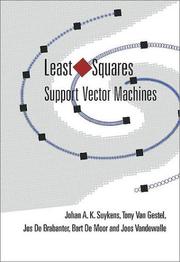
ISBN: 9812381511 9789812381514 9812776656 9789812776655 Year: 2002 Publisher: River Edge, NJ : World Scientific,
Abstract | Keywords | Export | Availability | Bookmark
 Loading...
Loading...Choose an application
- Reference Manager
- EndNote
- RefWorks (Direct export to RefWorks)
This book focuses on Least Squares Support Vector Machines (LS-SVMs) which are reformulations to standard SVMs. LS-SVMs are closely related to regularization networks and Gaussian processes but additionally emphasize and exploit primal-dual interpretations from optimization theory. The authors explain the natural links between LS-SVM classifiers and kernel Fisher discriminant analysis. Bayesian inference of LS-SVM models is discussed, together with methods for imposing sparseness and employing robust statistics. The framework is further extended towards unsupervised learning by considering P
517.5 --- 681.3*C12 --- 681.3*G12 --- 681.3*G12 Approximation: chebyshev elementary function least squares linear approximation minimax approximation and algorithms nonlinear and rational approximation spline and piecewise polynomial approximation (Numerical analysis) --- Approximation: chebyshev elementary function least squares linear approximation minimax approximation and algorithms nonlinear and rational approximation spline and piecewise polynomial approximation (Numerical analysis) --- 517.5 Theory of functions --- Theory of functions --- 681.3*C12 Multiple data stream architectures (multiprocessors): MIMD SIMD pipeline and parallel processors array-, vector-, associative processors interconnection architectures: common bus, multiport memory, crossbar switch --- Multiple data stream architectures (multiprocessors): MIMD SIMD pipeline and parallel processors array-, vector-, associative processors interconnection architectures: common bus, multiport memory, crossbar switch --- Moindres carrés --- Method of least squares --- Squares, Least --- Curve fitting --- Triangulation --- Multiple data stream architectures (multiprocessors): MIMD; SIMD; pipeline and parallel processors; array-, vector-, associative processors; interconnection architectures: common bus, multiport memory, crossbar switch --- Approximation: chebyshev; elementary function; least squares; linear approximation; minimax approximation and algorithms; nonlinear and rational approximation; spline and piecewise polynomial approximation (Numerical analysis) --- 681.3*G12 Approximation: chebyshev; elementary function; least squares; linear approximation; minimax approximation and algorithms; nonlinear and rational approximation; spline and piecewise polynomial approximation (Numerical analysis) --- 681.3*C12 Multiple data stream architectures (multiprocessors): MIMD; SIMD; pipeline and parallel processors; array-, vector-, associative processors; interconnection architectures: common bus, multiport memory, crossbar switch --- Moindres carrés --- Machine learning. --- Algorithms. --- Kernel functions. --- Least squares. --- Functions, Kernel --- Algorism --- Learning, Machine --- AA / International- internationaal --- 303.5 --- 305.976 --- 305.971 --- Theorie van correlatie en regressie. (OLS, adjusted LS, weighted LS, restricted LS, GLS, SLS, LIML, FIML, maximum likelihood). Parametric and non-parametric methods and theory (wiskundige statistiek). --- Algoritmen. Optimisatie. --- Speciale gevallen in econometrische modelbouw. --- Planning (firm) --- Operational research. Game theory --- Geodesy --- Mathematical statistics --- Mathematics --- Probabilities --- Functions of complex variables --- Geometric function theory --- Algebra --- Arithmetic --- Artificial intelligence --- Machine theory --- Foundations --- Machine learning --- Algorithms --- Kernel functions --- Least squares --- E-books --- Support vector machines. --- Apprentissage automatique --- Algorithmes --- Noyaux (Mathématiques) --- Theorie van correlatie en regressie. (OLS, adjusted LS, weighted LS, restricted LS, GLS, SLS, LIML, FIML, maximum likelihood). Parametric and non-parametric methods and theory (wiskundige statistiek) --- Algoritmen. Optimisatie --- Speciale gevallen in econometrische modelbouw
| Listing 1 - 9 of 9 |
Sort by
|

 Search
Search Feedback
Feedback About UniCat
About UniCat  Help
Help News
News